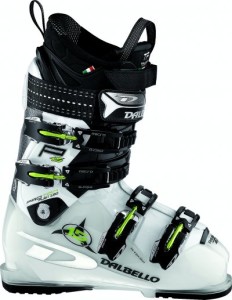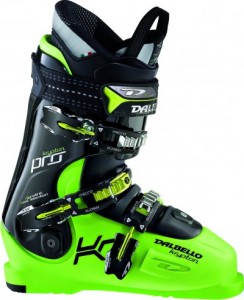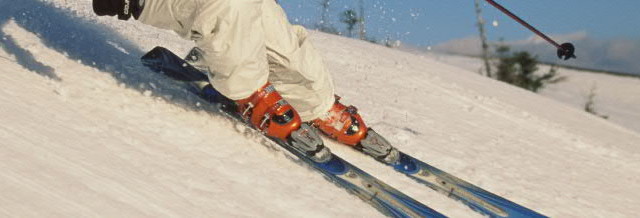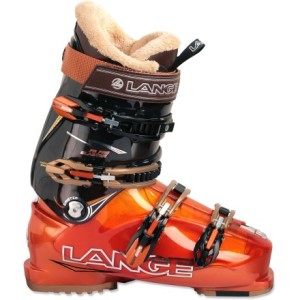For those of you who read “Ski Boots 101“, this is a longer article that discusses the process in greater detail. If you’re looking for some quick tips rather than the whole story, you may want to go there…or, ideally, read both to help you really understand the process of choosing a boot. So, on with our story…
A handful of years ago (if you’re an alien with a couple of extra fingers), I bought my beloved Lange Banshee X ski boots. I chose them based on the fact that someone had told me they were good boots, they looked cool, and they seemed to fit me okay. The guy at the store who was selling them to me didn’t seem to have any useful ideas, so I went ahead with them.
Now, this sounds like a dream come true, since I say “beloved” about them…but of course, life is never that simple. Cinderella had a miserable time getting those glass slippers that fit her perfectly (and which, if you remember correctly, fit NOBODY else but her!), and while I didn’t have to put up with a wicked stepmother, it took a long time to make my boots work well for me. The fact is that I shouldn’t have been in Lange boots in the first place. They’re a top quality boot, but I’ve got unusual feet…fairly wide in the forefoot, very narrow in the heel…and they’re just not designed for freaks like me. Paul Richelson at Feet First in Plymouth, NH got his hands on me and them and had a field day. The good news was that the fit was right in the forefoot, which meant that he could work on the rest of it. New, custom footbeds corrected some alignment problems, and a couple of hours of making pads to fill the area around my ankles gave me a liner that put pretty even pressure on all parts of my foot, holding me firmly in the boot without creating outrageous hot spots. Cinderella got her happy ending because the glass slippers were magically made to fit her; I got mine from some luck, some hard work, and a whole bunch of money. And, I was particularly lucky, since the boot matched my skiing style, so when I’d done all of the above, I really DID have the right boots!
Choosing Ski Boots: Nothing good lasts forever
Fast forward to 2007. Boots had changed a lot, mine were probably showing some weakness in places I wasn’t even aware of…hmm, maybe I should look at buying new boots. With that in mind, I took myself off to the ski industry’s big equipment show at Stratton Mountain. There, I was able to take advantage of my press pass and do something skiers normally can’t do…namely, actually trying different boots, skiing them for one run or several as I saw fit. The goal? To see if I could learn something about how to choose a boot that’s appropriate for me, and by extension, for you.
The first bit of good news for you is that you CAN’T try a bunch of different boots in a day…trust me, you wouldn’t want to if you could! Picture this…you put on your boots, which takes 5 minutes, get them set and buckled, go out, take a lift to the top, ski hard down the mountain…then go inside, rip the now ice-cold, rock-hard boots off your feet, put on a different pair…and repeat. And repeat. And repeat, until your shins are swollen and bleeding. Okay, so I’m whining, but if I never do that again, I’ll be a happy man!
Choosing Ski Boots: Only you know yourself
A disclaimer…this is NOT a “you should buy this boot” article. The fact is that I probably wasn’t trying boots that you personally would use. In fact, as you’ll see, I mostly wasn’t trying boots that I would personally use! There are a lot of different types of skiers, which is why there are so many boots. I’m a hard-charging type…I like to ski fast on fairly smooth steeps, making my skis work hard and really feeling the edges. If I were a freeride type skier, I’d want a very different boot…the type I use would be brutally painful on the shins of a freerider. If I used their boots, I wouldn’t have the control that I need at warp speed. KNOW YOURSELF, and choose boots that match your style! The goal of this article is to show you what I learned so that you understand what makes a boot right for me or for you, and to give you a step-by-step manual at the end to use when you go shopping for your next set of boots
Back to my boot voyage. This show was effectively like a skiing candy store…all the manufacturers, lots of models, try whatever I liked. I tried boots from Lange, Technica, Nordica, Dalbello, Alpina, Fischer, and Salomon. By the end of that, I couldn’t try any more…my feet and shins were so swollen from putting boots on and taking them off that I couldn’t feel anything. The first thing I learned is the boot stiffness is relative…one manufacturer’s “130” stiffness boot is very different from another’s. The second thing is that stiffness doesn’t mean a thing if the boot doesn’t fit right…movement of your foot inside the boot makes a bigger difference to how much you can make the ski do than any difference in stiffness. Based on what I learned, I now know that I can control a ski much better with a 100 boot that fits firmly, snugly, and comfortably than I can with an ill-fitted 130.
Choosing Ski Boots: Uncomfortable means comfortable…uh…what?
The next thing that I learned seems like a paradox…the most uncomfortable boot is a comfortable one. Huh? Okay, bear with me. When you put on a ski boot and it feels nice and comfy and like a slipper, it’s the wrong boot for you. When you put one on that embraces your foot and calf like an iron maiden (if you’re not into torture devices, you may not have heard of this thing, but feel free to Google “iron maiden torture”, and the images will say it all ), that one just may work. Here’s the problem. First, the nice and comfy one will have lots of hidden movement…when you’re putting your weight onto an edge, the liner will compress one way at the top and another way at the bottom, and by the time it’s finished doing that, you’re out of control. Second, when you get out of the 75 degree lodge and into the 20 degree air, your feet will shrink. That nice comfy boot now will be a size too big for you, and everything will move more. So…you’ll buckle down tighter to solve both of those problems. When you do that, you’ll put pressure on your feet where the buckles come across…in other words, pressure in three or four places rather than the whole foot/ankle/calf. Ouch. Hot spots, cramps, blisters, you name it. Oh, and frozen feet, since you’ll cut off the blood supply to your toes when you crank down that buckle over your instep.

Speaking of cold feet…I can hear you now. “But, I need a bigger boot so that I can get thick socks inside, ‘cause my toes get cold.” Well, it SOUNDS like it makes sense, but it doesn’t. The reality: bigger boot, thicker socks, more cranking down of buckles, less blood, more frostbite. A correctly fitted boot will allow more blood flow and warmer toes…yup, another paradox. Also, there are better solutions. Boots inherently let cold air in…it’s just the nature of the design. Until it gets really cold, it’s not a big deal…you’re working hard enough that the blood circulation keeps your warm. But…if it’s too cold for that, there are better solutions. Look at the pictures below. A naked boot is cold…the plastic shell transmits heat, and the open shell allows air through. A little duct tape covering that air gap at the toe will go a long way toward keeping your tootsies toasty. Better still, a neoprene boot cover makes a HUGE difference. It keeps the cold air out, and your own heat in. Boot Gloves, from The Dry Guy, can mean a temperature difference of as much as 20 degrees in the toe area! They’re inexpensive, easy to use, don’t take up much space in your bag…and they allow you to have the right boots, fitting right, without thinking about using thick socks.
Socks. I used to use some nice, middleweight Smartwool socks. No longer. They were too thick, and as the day went on, they’d compress. The best choice is a thin sock of pretty much anything other than cotton. Darn Tough is my favorite, but Smartwool, Thor-Lo, and a number of other brands make excellent products. Make sure they come up over your calf so they stay up and keep snow from working its way down inside. Choose the socks you like BEFORE you go shopping for boots, and always try boots on with YOUR socks, never with what they have at the shop. That little detail can make the difference between boots that fit and boots that are too big or too small. While we’re at it, remember that your feet are bigger when it’s warm, like in the store…and smaller when it’s cold, like when you’re skiing. Add a sock that’s too thick, and your liners packing out a little, and it’s easy to buy a boot that’s two sizes too big when you’re actually skiing.
Choosing Ski Boots: Finding the Holy Grail, then making it work for YOU
Back to the quest. What did I learn about the specific boots? Well, the first thing is that boots have come a LONG way since I bought my old Banshees. Materials are different, the buckles are better, the powerstraps at the top of the boots are wider and stronger, and material has shifted to take into account the way the new skis work. The boots are stiffer laterally (so that you can get the ski up on edge), and softer fore-and-aft, making it easier to flex your knees. They’re also more fun to look at (my old Langes were “cosmetically challenged)…the manufacturers are making sure that you enjoy the way your boots look, as well as how they feel.
The second thing is that fit matters more than anything else. Period. End of discussion. This IS the Holy Grail of ski boots. No question. I was using absolute top-of-the-line boots from the absolute top-of-the-line manufacturers, and the ones that worked best were the ones that fit best. Interestingly enough, the boots that worked LEAST well for me were the new Langes! As I know from all the work I had to do to the Banshees, they don’t inherently fit my foot well…and when I tried an off-the-shelf pair, it became painfully (literally) obvious. Gorgeous boots, all the new “right stuff”, and I couldn’t turn as well with them as with my ancient ones. Even when I cranked the buckles down enough that I wanted to cry, there was still enough movement in other parts of my foot/ankle area to keep my turns from being as crisp and controlled as I’m used to.
The third thing was to watch out for the shaft angle of the boot. Okay, I know that makes no sense….bear with me. Take your boots, put them so you’re looking at the sides of them, and notice that the upper part of the boot (the “shaft”) isn’t vertical. It leans forward, because when you’re in position to ski, you’re leaning forward into them, too. Correct shaft angle is critical. The Fischer RC4 is a gorgeous boot, felt like it fit beautifully…and I couldn’t make the skis sing with them. Not the fault of the boot…more like the fault of my booty. I have a somewhat, um, heavy back end, which pulls my lower legs fairly upright when I’m in my skiing stance. The Fischers had a sharper forward angle to the shaft, and I simply couldn’t pressure the front half of my ski correctly. Now, some boots have adjustable shaft angles…but if you’re in the shop, standing in your normal skiing position, and you aren’t feeling the boot pressing pretty hard against your shin, it’s got the wrong shaft angle.
Choosing Ski Boots: Remember that “know yourself” bit?
The fourth thing is to know your strengths and your weaknesses, and to look for a boot that plays to your weaknesses. For instance, I’m best at the very unsubtle art of driving hard down a mountain at pretty high speeds. All power, no grace. If I wanted to play to my strengths, I’d get the Technica Diablo Race Pro. With the power of that boot, I could set an edge in solid granite…but I can do that pretty well with most boots. What I’m worst at is quick, short-radius turns, going edge-to-edge by the side of the trail or in crud. The boot that emphasizes my strength would make me even worse at it, and keep me from enjoying all the different trails and conditions. So, I need to look for a boot that’s stiff and strong enough to put up with my weight and power, but otherwise is almost a boot for a freerider. Those guys are all about being light in their feet and well balanced in all conditions. A full-on downhill race boot wouldn’t work for them, and would be a lousy choice for me (unless I was going to have multiple pairs of boots for different conditions). So…when I tried the Technica, it was a blast in the icy steeps at the top…total control. Down closer to the bottom, where things started to break up…not so much fun. The boot’s natural stiffness coupled with MY natural stiffness made it really bang against my shins as I worked my way through the lumps and bumps of the powder they were blowing out of the snowguns. Not the boot for me…but if I ever decide I want to race Super G, I’ll be back for them!
That leads to the fifth thing…know the type of skiing you want to do. If I really did want to race, and that’s all, I’d be looking at a very different boot than I am. The same goes with freeriding…if I did that, I’d want a boot that’s softer than what I’m going for. As it happens, I have what are called “all-mountain” skis, since I like to do a little of everything…and that’s what I want in a boot. So, figure out what your goals are, and look at how the manufacturer describes the characteristics of the boot. Remember, they don’t want you to be unhappy…they’re going to try to get you to buy the boot that they make that will best fit your skiing style. Since you can’t try the boots on the slopes, that description is the best indicator of whether the boot is the right type for you.
Choosing Ski Boots: Don’t lie!
Okay, I know this is getting complicated, and I’ll be summarizing it later. Still, there’s a 6th point…weight. Sorry, but this may involve getting the scale out. I weigh about 175, and I ski hard, so I can bend a pretty stiff boot. My friend Ralph weighs about 30 pounds less than I do…if he used the same boot that I do, it would be too stiff for him, and he’d be uncomfortable. Someone who weighs 225 would laugh at my boots…they’d be flexing all over the place, and the skier would have no control. The weight/stiffness ratio is relative to how you ski, but keep it in mind…if you’re a small person, don’t get a hugely stiff boot, and if you’re a big person, don’t get a softie.
Choosing Ski Boots: Finding Baby Bear’s bed–for me, that is, not you.
Now you have an idea of the things I was learning to take into account while I tried all those boots. I felt like Goldilocks…one boot was too firm, another was too soft, the shaft angle was wrong on a third. And, of course, the fit varied all over the place, as it should…we all have different foot/ankle/calf shapes and sizes, and if everyone used the same dimensions, most of us would be out of luck. And, of course, I have difficult feet to fit…custom work is mandatory for me. I’m tempted to say that it’s mandatory for you, too; if you’ve never had yourself checked out by a quality pedorthist, you have no idea what your feet are doing. Pronation or supination by as little as ½ of a degree can significantly change how you use your edges, and you have NO idea how good you can be when things are aligned correctly! When you think about the thousands of dollars that you spend on skis, boots, poles, clothing, tickets, the idea that you’re missing out on the best that you have to offer over a few hundred dollars of custom work seems pretty silly. I can’t make you get checked out…but I can certainly recommend it!

Okay, so…where does all of this lead us? In my case, it led me to one boot, and perhaps the last boot I’d have imagined I’d have chosen. Dalbello makes two high-end boots, the Proton and the Krypton. The Proton’s a 4-buckle design…perfect for a skier like me. The Krypton’s a 3-buckle, so should be too flexy. But wait…there’s magic here! Take a look at the photo and try to ignore the alien-ooze green color. Notice where that middle buckle is? It pulls your heel down and back into the heel cup so it doesn’t move! With that locked in, it’s easy to tighten the toe buckle and shin buckle enough to make it snug, but not so tight that I’m hurting. That, coupled with the incredibly versatile (and difficult to understand) system of different tongues and shims allowed me to set the boot up so it worked for ME, not someone else. Immediately, I noticed a gain in control and edge-to-edge speed over the Banshees. Short radius turns are the bane of my existence, yet with these boots, I found them easy (Okay, full disclosure…Tim still says that I’m about as graceful skiing as a warthog, but at least I can DO the turns I want)! Clearly, there’s something here requiring more study.
Choosing Ski Boots: Is the proof in the pudding?
Last year, just as the spring snow was starting to go away, my Dalbello Krypton Pro boots with the Thermo ID liner appeared on my doorstep. Of course, there wasn’t enough snow or time left to really test them out and see if all of my testing had paid off the way I’d hoped it would. So, there’s followup to be done here! And, just to confuse things more, a new boot that’s even weirder than the Krypton has appeared on the market…the Apex. I’m going to try to get my feet into a pair and see how utterly unconventional new technology compares to utterly unconventional old technology. Follow the link for the review!




I bought my first pair of ski boots ever . . . and think I found a good match. I don’t have much of a back log of previously used boots to compare them too. I will tell you that my first two times out on the slopes were miserable because of a boot issue and I was ready to give up on them. I had the top clip cranked down so much that I lost circulation in both feet. I tried putting it on the very last clasp and it still left me numb. I didn’t realize the actual clip could slide out further (tricky feature for a beginner with her own equipment for the first time). Once it was adjusted the boots were like heaven . . .and my calves were breathing again so the tingle in my toes went away! Now if I was to do it again I would have the boot sales crew show me all the bells and whistles of the boot before I left the store!
[…] Boot Gloves cost about $30 a pair and each pair seems to last me about 2 seasons (roughly 150 days of use). That’s much cheaper than battery powered boot heaters. I can’t use disposable heat packs — they simply don’t fit inside my boots. In fact, if they fit in your boots, that’s a pretty clear indication that your boots are probably too big for you and hurting your skiing. For somequick thoughts on getting the right ski boots for you, go here; or if you want more in-depth information, go here. […]